Today we
were on bus 7, and with a new group of people. John had suspected some would be
too tired after yesterday to do day 2 but I didn’t accept that. I was wrong, as we did hear of a few who
opted out of the second day, but most people were back on the buses.
Our new
guide was Maria and our driver was Alexander (“the Great”). She taught us a bit
of Russian as we drove in to the city. Today we had on our tour agenda a small
part of the Hermitage museum, lunch, the palace where Rasputin was killed, and
the place where the Tzars are buried.
We drove
past the rather dismal apartments that she told us were built in the 1970’s and
heard about the public transport system. The subway system is very deep (350
feet) and relatively underused although we know the stations are lovely. There
are also public taxis that you can hail and pay the same price as a bus.
Maria had
a rather dry sense of humour. She said that people from California often ask
why people don’t smile here and she said ‘would you smile if you had 60 days
with sun a year’.
We have been lucky and have had 2 wet days of the 80 on this
trip. She also said that people in St Petersburg had 9 months of anticipation
as summer approaches then 3 months of disappointment.
St Petersburg
is near the Gulf of Finland which is shallow and the water has a very low salt
content. The city itself has 65 waterways and over 300 bridges. The bridges on
the main river, Neva, are all drawbridges, and are raised at night for 4 to 5
hours to let big ships through.
We
stopped on the embankment to take photos of the Sphinx and a submarine, and
then we spotted our Canadian friend Barbara from yesterday’s tour. We had a
catch up about her evening at the ballet, which she had enjoyed, but had been
rushed to get back out by 7pm. The various Royal Places here were also pointed
out to us again. One now houses the University of St Petersburg and also
extends back a few blocks, while the Winter Palace and others are part of the
1000 room Hermitage. The nearby Palace Square is the third largest in Europe.
Things
were again being prepared for Naval Day which we think is this weekend. It is
obviously a major event here.
We then
stopped near an active Orthodox church, Our Lady of Kazan Cathedral, to allow
photos to be taken. As it is an active church the guide did not take us inside.
We also ook photos of the Singer building (yes after the sewing machine but
known for its bookstore) and of Nevsky Prospect. The street we were told is the
St Petersburg equivalent of the Champs-Elysees. We also meet up with Barbara again,
and we agreed to meet for dinner in the evening.
We
arrived at a side entrance to the Winter Palace at an area that was opened
early just for cruise passengers on tours. It was a big bonus to be able to
walk through relatively empty rooms here, especially after we had seen the long
queues waiting for the ‘normal’ opening hour. We had been told in advance that
the Palace was built by 1759 with all rooms decorated with gold leaf and the
building painted yellow. The monumental scale was to reflect the power of
imperial Russia. There had been a fire here that burned for 3 days, although
many items were saved and the Palace was immediately rebuilt. The exterior was
left basically unchanged but the interior decorations were redesigned in 19th
century styles.
The rooms
were all ornate and a huge contrast to the streets outside which seemed so drab.
The floors were also parquet but we did not have to were overshoes because we
were not in an area with gardens that could pick up stones on the soles of your
shoes.
We had to wait in one room for a short time while the guide waited for
permission to move into the next room where the door was shut. It was a
condition of the early opening that we could only go into prescribed rooms
although once the museum was open she could choose the route to follow. The
golden rooms had mainly columns and fittings covered in gold leaf which we were
told was thinner than paper and applied using squirrel tail brushes as they
were the only things soft enough. Maria pointed out the areas that had lost
their covering as people had touched them.
The Hermitage
was built as a contrast to the Winter Palace by Catherine the Great who wanted
a quieter area that she could not find in the other 1000 rooms!!! They were the
apartments for the family, with the Palace used for official occasions. In fact
it was really another large Palace and there were 3 parts with the name, the
Old Hermitage, the Small Hermitage and the New Hermitage. The name Hermitage is
now used to describe the whole museum complex. The new areas were filled with art
bought often as ‘job lots’ from other people’s collections.
We saw
the Malachite room and had the word explained to us. It is a semiprecious green
mineral and the room was full of columns, a large urn and other furniture and a
fireplace faced with the mineral. It was done in a style Maria referred to as
Russian mosaic where you could see that it was pieced together only when
looking very closely at the surface.
In the
concert hall there was a tomb made with 2 tonnes of silver and in the Field
Marshall room a 2 tonne chandelier that we were warned not to stand under.
Maria ensured we saw the Main Staircase and also said that would be the meeting
area if anyone got separated from the group. As she also said that a local joke
is that half the people in St Petersburg work at the Hermitage and the rest are
lost in there somewhere. This ensured we kept close to her.
In a
number of spaces the double headed eagle, the imperial symbol was pointed out
to us. It was often on the ceilings. This had been removed in the time of the
Russian Revolution and restored when the various rooms were renovated.
We went
into the Emblem room, the only room that had suffered in WW2. We were told the
Hermitage had been covered in a net that had garden scenes on it so was not
bombed. The room that suffered was from a bomb that had missed its actual
target.
We had a
bonus in one area when our guide spotted that the route to the Domestic Church
was open.
This was the church the Imperial family used if they were not at
major occasions at St Isaac’s. It was not like most domestic churches but then
most people don’t have a church in their own homes.
The
throne room was very ornate and also interesting. Maria pointed out that the
parquet floor had exactly the same design as the ceiling. There was only one
exception. The ceiling did include some double headed eagles and they were not
on the floor as walking on these would be very disrespectful.
The
Gallery was built to display the various artworks bought by the various members
of the Imperial family. It originally had arched windows on both sides until
the buildings were expanded and then one side had the windows replaced by
mirrors. It had been built as a direct copy of the gallery by Raphael in Rome
except the artwork was on canvas not frescos. Artists had been sent to Rome to
make exact copies and then they were placed on the wall and ceilings here. The
canvas was very thin so it could be on the walls and ceilings and look like
frescos.
We saw
another room where lapis lazuli had been used also as Russian mosaic to make a
blue covering.
There was
a space with a very ornate18th century clock that is now only wound once a
week. There was a video nearby that showed it in action with the peacock moving
its head and opening its feathers. In the same room was a table with minute
tiles so only a close look showed it was mosaic as well and a lovely ebony
table.
Doors in some places were ebony with tortoiseshell and gold plating.
We only
saw a few of the art treasures of the museum. Later someone wondered why we
didn’t go there first but I suspect we were not allowed to. Maria was good at
trying to pick a route that was not too busy but in some spaces she had no
choice. Here she often told us what to go and look for and suggested as
individuals we could be more pushy and use our elbows. We saw several
Rembrandts, one of which had been attacked with acid and a knife in 1985. She
explained that Rembrandt had been taught to paint thickly with lots of layers
and that had allowed it to be restored. After 13 years and removing 13 layers
of paint, the artwork was able to be put back on display. Now a number of
pieces have glass over them.
We also
stopped at the only Michelangelo sculpture in the museum. It was incomplete as
we could clearly see from the front. But then she told us to look at the back
and it was so human.
Our final
visit was to see an enormous Jasper vase. It was so big that a wall had to be
removed to install it.
As we
left someone asked Maria how long it took to enter if you joined the actual
queues. She said she had no idea as she never tries to visit as an individual
anymore. We were told to listen for the blank shot that is fired at noon each
day and not to be concerned that it was some form of attack.
After we waited
for a couple to join us who had got lost, we went to a ‘boat’ for lunch.
We
were warned it would be hot, but perhaps because of that we were prepared and didn’t
find it too bad. The meal was a huge improvement on the previous day as well,
and the lack of entertainment meant we had time to talk.
The next
visit was to the Yusupov Palace. This had been built by a family that were more
wealthy than the imperial family and this was one of their 50 palaces. They had
given service to the various Tzars and that had expanded their wealth. They
also had mainly had small families and also tended to marry up. One of the last
members of the family had been educated at Oxford and there was meant to be an
English influence in the building, although I admit to not being aware of
it.
This
palace was on the agenda though because it was where the death of Rasputin was
plotted and carried out. The lower rooms were set up to display the happenings
of the evening. The main issue was that numbers are very restricted which had
us waiting first in the street and then inside for ages.
Maria
gave us the details before we went in.
She reminded us that Nicolas and Alexandra’s
only son was haemophiliac and that Rasputin was seen by them as their only
hope. He grew in influence over the imperial family to the extent that many influential
people were concerned. She said that there are 2 theories. One is that it was a
local plot to kill him planned by Felix Yusupov, the son of the family, and 3 other
Russians. The newer theory is that it was an international plan as many other
countries in Europe, including Britain, were concerned that a powerful country
like Russia was so influenced by him, and it was dangerous for the stability of
the region.
We were told that a military doctor obtained cyanide for them
and it was served to him by Felix cooked in cake, which rendered it harmless. I
later heard it was served in red wine. When he found that Rasputin was still
fine, Felix shot him as well. Felix joined the other plotters. Then they found
that Rasputin was still alive and escaping through a side door. They shot him
twice more and the shots were heard by the police. They then bundled him up and
threw him in the river. When the body was found, he had died of drowning/hyperthermia.
The plotters were identified and the doctor sent to the front while the others
were exiled. Felix managed to re-enter Russia again but the Palace was
confiscated during the Revolution. The woman who is the descendant of the
family lives in Greece and has no interest in visiting the Palace we were told.
We were also told the family had fled with most of their jewellery.
The displays were OK but not really worth the heat and the wait.
We then went upstairs to see the Palace. It had electricity and
later an elevator before any of the royal residences, which reflected the
wealth of the family. It had been used as a teacher’s club after the property
was confiscated, so had been reasonably well treated, although spaces had been
divided into offices. The Palace had its own theatre inside which Maria said
had been used for opera evenings offered through Holland America in the past.
The place was as ornate as the palaces we saw in the morning with parquet
floors and a malachite fireplace (one of only 3 in Russia). The Oak room was as
describe; oak floor, oak ceiling and oak furniture. The ballroom had a male group
who sang a lovely rendition of a Volga boat song. We also went into the private
theatre, which was relatively small but was otherwise a complete theatre.
Back in the coach I was delighted when we had time for a photo
stop at St Isaacs Cathedral.
We could see people who were walking through it
and up the 260 steps of the tower for the views. It is the largest Russian
Orthodox Church in the city, although it looks more like a Catholic church as
it was built in Italian style. It is the 4th largest cathedral in
the world and we had seen it from a number of angles during the day. The dome
is covered in gold and 100m high. During WW2 it was painted over to protect it
from enemy bombers.
Our next stop was on the other side of the embankment to allow
us to take a panoramic of the Royal Palaces. Sadly I forgot how to do that on
my phone and John was quietly snoozing. When we got to the final stop people
were given the option of staying in the bus so I didn’t wake him, something he
was delighted about he said later.
This stop was at the Peter and Paul Fortress/Church. It is the
first structure built by Peter the Great in St Petersburg between 1712 and 1733.
The bell tower with spire is the world’s tallest orthodox bell tower and
visible all over the city.
This is also the burial place of most of the
Imperial rulers from Peter the Great onwards, with their tombs being just
inside the door we entered from. Maria told us to use our elbows and see them
first, then the space where the last of the family, Nicolas II and his family
and servants are buried. The last to be buried here was the mother of Nicolas
who died in exile in her native Denmark and was reinterred here in 2006.
The only issue we faced here came as we were leaving. The same
couple who were late from the Hermitage also got lost again, but luckily were
found in time for us to be back at the planned time of 5pm.
Once again, I went to the pool to relax my feet, before dinner.
We enjoyed meeting Barbara’s mother Lorna, and had a long chat with both of
them over our meal. Lorna is as sharp as a tack and very well-travelled so had
a lot of interesting things to say. We agreed to meet again near the end of the
voyage to hear how their trip had been.

 Saint Petersburg, Russian Federation
Saint Petersburg, Russian Federation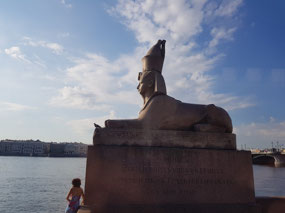
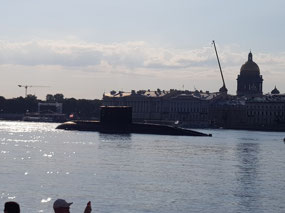
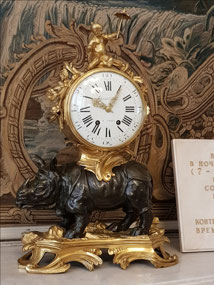
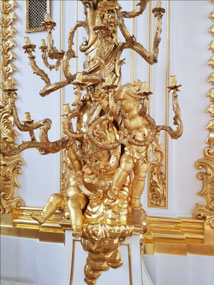
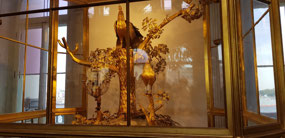
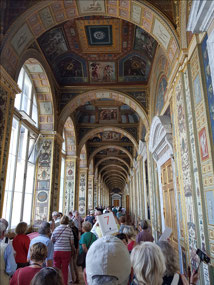
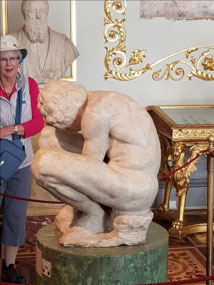
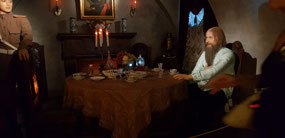
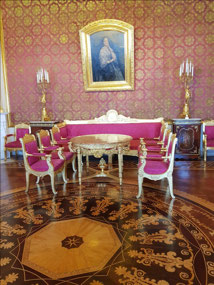
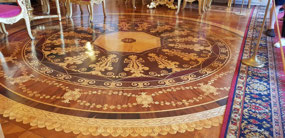
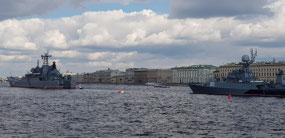
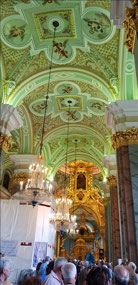









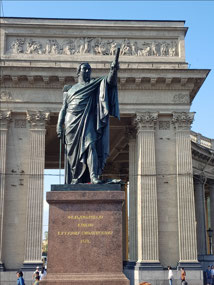
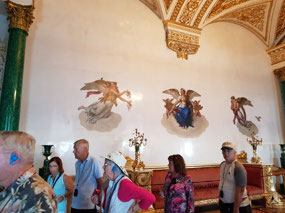
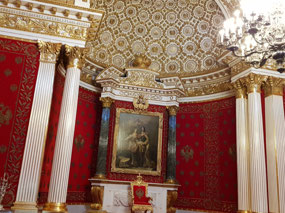
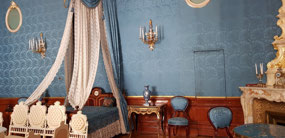
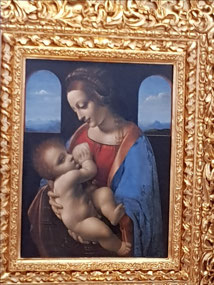
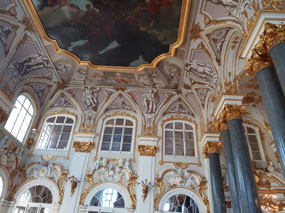
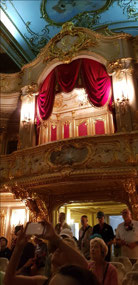
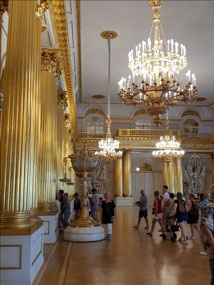
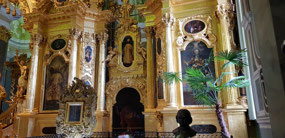
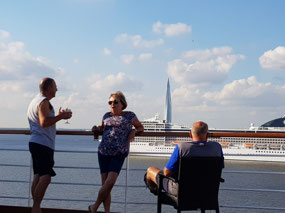
2025-05-22